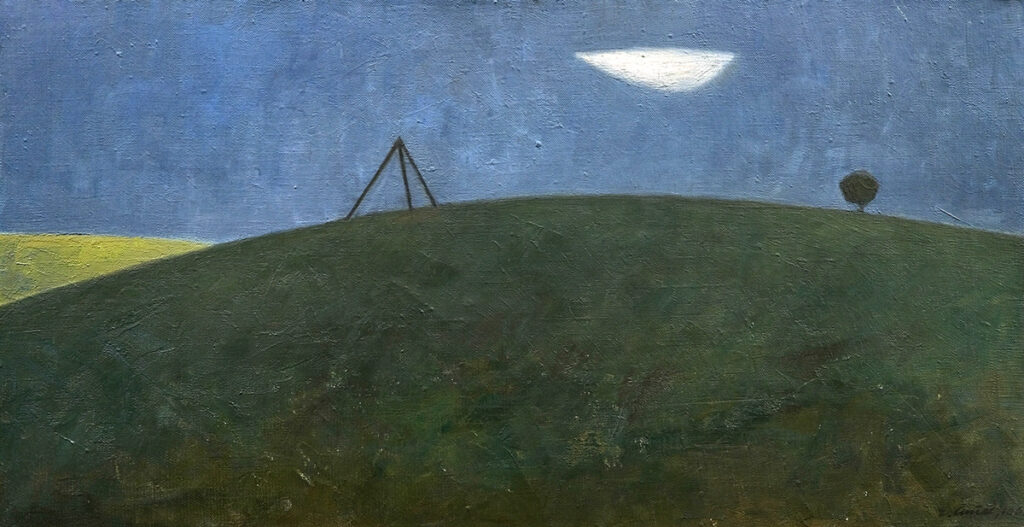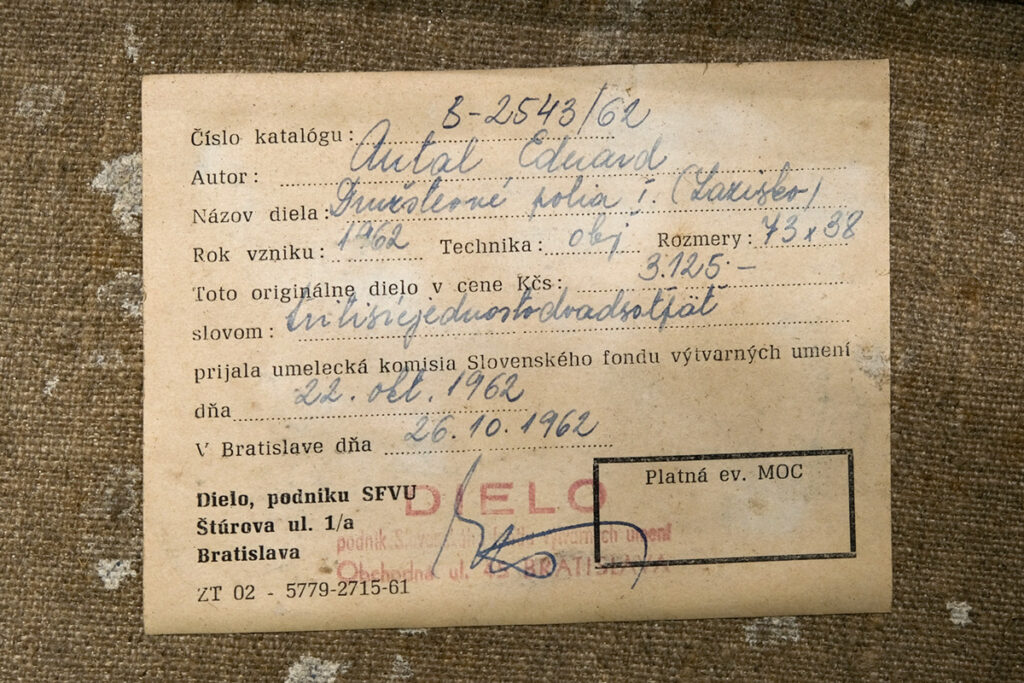A landscape panorama with fields may seem like a rather hackneyed genre theme, but in case of the Agricultural Fields series by Eduard Antal, it represents an interesting case of a gradual move from specific subject matters to geometric abstraction in Slovak fine art at the beginning of the second half of the 20th century.
The Agricultural Fields I painting, which is a part of the Nitra Gallery collection, features wide-open green fields, there is also a fragment of a yellow field emerging from the left part of the background. There is a hay drying rack1 and a tree on the horizon. A lonely white cloud of an unusual shape floats across the sky, looking like a bowl or a boat. The painting has an interesting aspect ratio of 2:1, which if often used in cinematography or various mobile phone screens. The format offers a widescreen view and it does not seem unnatural at the same time. The image composition and layout rely on large surface areas with a reduced, earthy colour palette. Antal tries to use simplification and reduction in his search for essential forms and the way they are depicted. Stylisation and simplification in landscape paintings were the results of the artist’s professional development, but they were also influenced by observing his birth region (the surroundings of Lučenec), which was going through several changes after WWII. Small and scattered fields and pastures had started to form into large and uniform monocultures probably as a result of collectivisation.2 Eduard Antal’s landscape paintings were also influenced by his university teacher Bedrich Hoffstädter – “his rational constructivist approach to landscapes and thoughtful work with compositions and light had become the groundwork for Antal’s further direction and his focus on reduced expressive means.”3
When we take a look at the back of the painting titled Agricultural Fields I, the information label has the word “Lazisko” written in parentheses right next to the image title. A village of the same name lies in the southern part of Liptov region at the foot of the Low Tatras, not far from the Demänovská Valley. Antal, in his interview in the book Slovak Studios, recalls his studies like this: “…they would take students outside, fine artists and architects had a spot where you need to take a turn toward Pavčina Lehota, heading toward Demänovská Valley. There were beautiful cabins there. It used to be visited by old man Schurmann, Mr. Bazovský, their generation.”4 We can thus assume that the painting in the Nitra Gallery collection was most probably inspired by the region of Liptov. Plein air painting5 was important for Antal even after his studies. In the second half of the 1960s, together with his wife and artist friends gathered around the Group 66 (Elvíra Antalová, Zuzana Rusková-Bellušová, Ján Švec, Marián Velba), they would go on annual trips around Slovak countryside where they could explore the land and how it was lighted during different times of the day. On their trips, which they called “doodling”, they would create drawings and aquarelles which would serve as foundations for their oil paintings which they made later in their studios.6 Eduard Antal’s wife Elvira was also a landscape painter, one of her works of the same name, Agricultural Fields I, is actually a part of our collection, too. Even though the spouses would initially paint similar themes – Antalová would mostly use aquarelles or tempera on their trips while Antal preferred drawing – their creative paths would gradually divert from each other as they both started finding their own way.7 Antalová’s work was mostly emotional while Antal took a more rational approach to his creative process.8
A very similar image to Agricultural Fields I is reproduced on page 18 in a publication about Eduard Antal published by Závodný Gallery in Mikulov in 2018. Their compositions are almost identical, they only differ in their colour schemes and a few details: the older painting (Field, 1961, oil on cardboard, 27 x 50 cm) features fields with black outlines, the tree is more like a shrub as it does not have a trunk and the hay rack has crossed slats. Vladimíra Brucháčková Závodná identifies two different approaches Antal would focus on during this creative period when his favourite motifs were fields and meadows: “The first one makes use of the translucent properties of individual oil paintings. Thanks to their smooth and semi-translucent glaze, we can observe the various colour levels as well as the repetitive canvas texture (e.g. the Agricultural Fields series, 1963). Another group of paintings typically carried thick layers of coloured paste, giving almost haptic and spatial impressions. There are apparent spatula marks and nicks in the layers of colour (e.g. Fall Landscape, 1963, Fall, 1964, Land, 1964).”9
So if we are to compare the Agriculture Fields I painting with other paintings from the Agriculture Fields series from other Slovak galleries’ collections, or even form our own collection (Agriculture Fields, 1963, oil on canvas, 38 x 55 cm), we can consider this image to be interesting and unique in the sense that despite its title, it does not formally fit into the series and we could consider it a part of another group of Antal’s images inspired by fields.
Eduard Antal (May 18, 1929, Vidiná – November 21, 2011, Bratislava)
Between 1949 – 1953, he studied in Bratislava at the Faculty of Education at Slovak University (the Comenius University’s name between 1939 – 1954) under prof. Gustáv Mallý and other teachers – Bedrich Hoffstädter, Eugen Nevan and Eugen Lehotský. Upon graduation, he started to work as an assistant lecturer at the Faculty of Architecture and Civil Engineering at the Slovak Technology College in Bratislava (today’s Slovak University of Technology) where he remained teaching until 2006. In 1978, he was named assistant professor of drawing and in 1988, he received the title of professor of fine arts – painting, and led the studio of drawing and modelling. In 1953, he married the artist and educator Elvíra Knotková. As a guest, he exhibited with the Concretist Club and later became a member of this important Czechoslovak association of artists (1968 – 1972, members: Jiří Valoch, Tomáš Rajlich, Radoslav Kratina, Eduard Ovčáček, Miloš Urbásek, Alojz Klimo, Tamara Klimová and others). He was also a member of the Union of Slovak Fine Artists, Slovak Union of Visual Arts, Slovak Art Forum, the Geometry Group and founder of the Group 66.
His work focused mostly on painting, freelance and professional printmaking and monumental decorative elements in architecture (compositions made of polished aluminium). The basis for his work was nature, its formal diversity and laws of physics such as strength, rotation, gravitation or waves. An important element of his works is the play of light and shadow where any change in lighting creates an illusion of optical movement. He relied on either clear or structured surface, created white reliefs on fibreboard using an original technique of layered and sanded plaster. He would gradually reduce the colour palette and finally end up with pure white on white background in the late 1960s. He is known for his white blind prints (also a part of the NG collection). He would gradually simplify his motifs with the intention of elevating them to the position of a sign and thus he has become one of the most important representatives of Slovak geometric abstraction. His work was influenced by science, technology and mostly architecture – probably because he spent most of life teaching at the faculty of architecture.
— Omar Mirza, May 2023
Notes
1 Traditionally used for drying hay in open air, see: https://www.ludovakultura.sk/polozka-encyklopedie/ostrva/ (accessed on May 24, 2023)
2 See the interview with Antal’s daughters Zuzana Duchoňová and Jana Antalová, in: BRUCHÁČKOVÁ ZÁVODNÁ, Vladimíra and Petra KORLAAR. Eduard Antal. Mikulov: Závodný Gallery, 2018. ISBN 9788090706712, p. 88.
3 ibid, p. 94.
4 Quoted from: DORIČOVÁ, Denisa Gura and Daniel BRUNOVSKÝ. Slovenské ateliéry [Slovak Studios]. Bratislava: Virvar, 2010. ISBN 9788097034740, p. 19.
5 The expression “plein air” (from French “en plein air” – “outside”, literally means “in open air”) is traditionally used in art language to describe painting in nature using direct sunlight and atmosphere of the actual landscape motif.
6 Same as note [1]
7 See the interview with the Antals, in: DORIČOVÁ, p. 18.
8 BRUCHÁČKOVÁ ZÁVODNÁ, p. 93
9 ibid, p. 12 – 13
Bibliography
DORIČOVÁ, Denisa Gura and Daniel BRUNOVSKÝ. Slovenské ateliéry [Slovak Studios]. Bratislava: Virvar, 2010. ISBN 9788097034740.
BRUCHÁČKOVÁ ZÁVODNÁ, Vladimíra and Petra KORLAAR. Eduard Antal. Mikulov: Závodný Gallery, 2018. ISBN 9788090706712.
Inventory No.: O 19
Artist: Eduard Antal
Title: Agricultural Fields I
Year of origin: 1962
Technique: oil
Material: canvas
Dimensions: height 38 cm × width 73 cm
Signature: bottom right, in brush: E. Antal 1962

